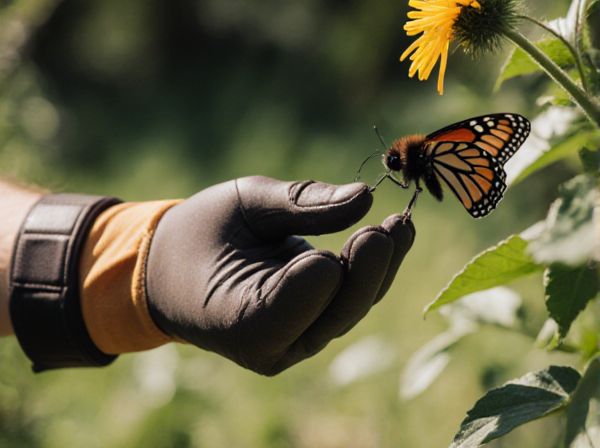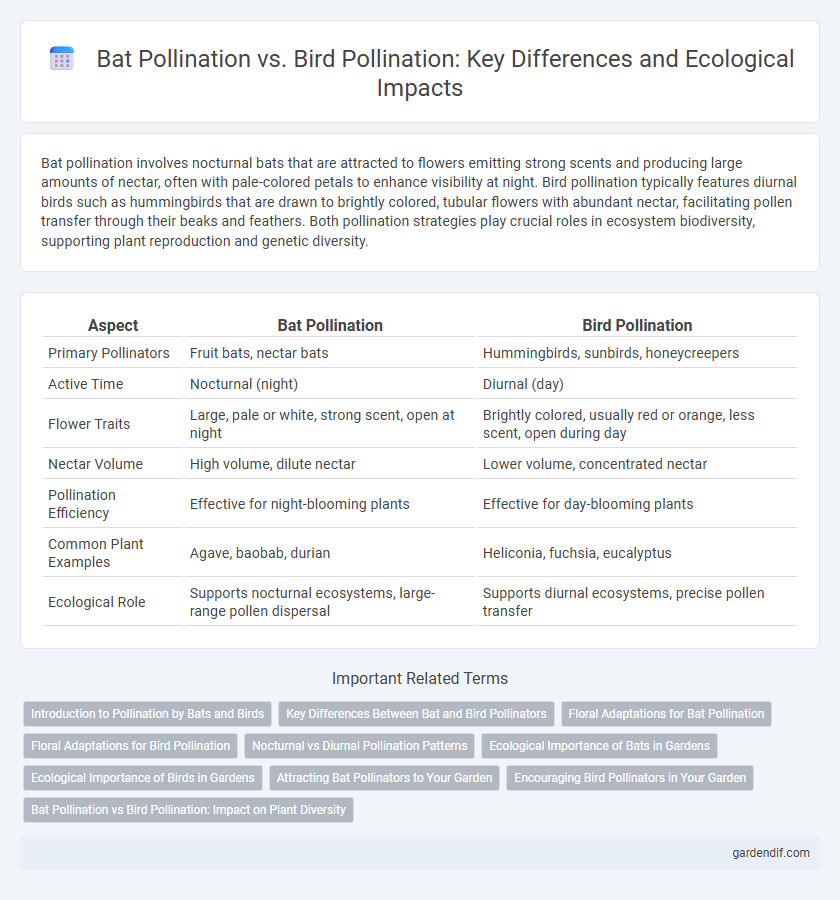
Bat pollination vs Bird pollination Illustration
Bat pollination involves nocturnal bats that are attracted to flowers emitting strong scents and producing large amounts of nectar, often with pale-colored petals to enhance visibility at night. Bird pollination typically features diurnal birds such as hummingbirds that are drawn to brightly colored, tubular flowers with abundant nectar, facilitating pollen transfer through their beaks and feathers. Both pollination strategies play crucial roles in ecosystem biodiversity, supporting plant reproduction and genetic diversity.
Table of Comparison
| Aspect | Bat Pollination | Bird Pollination |
|---|---|---|
| Primary Pollinators | Fruit bats, nectar bats | Hummingbirds, sunbirds, honeycreepers |
| Active Time | Nocturnal (night) | Diurnal (day) |
| Flower Traits | Large, pale or white, strong scent, open at night | Brightly colored, usually red or orange, less scent, open during day |
| Nectar Volume | High volume, dilute nectar | Lower volume, concentrated nectar |
| Pollination Efficiency | Effective for night-blooming plants | Effective for day-blooming plants |
| Common Plant Examples | Agave, baobab, durian | Heliconia, fuchsia, eucalyptus |
| Ecological Role | Supports nocturnal ecosystems, large-range pollen dispersal | Supports diurnal ecosystems, precise pollen transfer |
Introduction to Pollination by Bats and Birds
Bat pollination primarily occurs in nocturnal plants with large, sturdy flowers that emit strong, musky scents to attract bats, which rely on echolocation and smell for foraging. Bird pollination, especially by hummingbirds, involves brightly colored tubular flowers rich in nectar and often open during the day, catering to birds with keen vision and high energy demands. These distinct pollination strategies reflect evolutionary adaptations to the sensory capabilities and behaviors of bats and birds, enhancing plant reproductive success through specialized mutualism.
Key Differences Between Bat and Bird Pollinators
Bat pollination primarily occurs at night, with bats attracted to flowers that emit strong, musky fragrances and produce copious amounts of nectar, typically featuring pale or white colors for visibility in low light. Bird pollination usually takes place during the day, targeting brightly colored flowers, especially red and orange, rich in nectar yet often lacking strong scent, as birds rely more on vision than smell. Morphologically, bat-pollinated flowers tend to be large, robust, and open wide to accommodate bat access, whereas bird-pollinated flowers are tubular or elongated to fit bird beaks, facilitating efficient pollen transfer.
Floral Adaptations for Bat Pollination
Floral adaptations for bat pollination include large, sturdy flowers with pale or white colors to enhance visibility in low light and strong, musky or fruity scents to attract nocturnal bats. These flowers often produce abundant, dilute nectar contained in robust floral structures capable of supporting the weight of visiting bats. Unlike bird-pollinated flowers, which typically have bright colors and tubular shapes, bat-pollinated flowers exhibit open, bell-shaped corollas facilitating easy access for bat tongues and facilitating pollen transfer during feeding.
Floral Adaptations for Bird Pollination
Floral adaptations for bird pollination typically include bright red or orange tubular flowers with abundant nectar to attract hummingbirds and other bird species, which rely on visual cues more than scent. These flowers often have sturdy structures and elongated shapes to accommodate bird beaks and minimize nectar spillage during feeding. Unlike bat-pollinated flowers that open at night and emit strong odors, bird-pollinated flowers primarily bloom during the day and possess limited fragrance.
Nocturnal vs Diurnal Pollination Patterns
Bat pollination primarily occurs during nocturnal hours, with bats attracted to pale, strong-scented flowers that open at night, whereas bird pollination is predominantly diurnal, involving brightly colored, tubular flowers adapted for daytime vision. Nocturnal pollinators like bats rely on scent and echolocation, while diurnal pollinators like birds depend on visual cues and abundant nectar production during daylight. These distinct pollination patterns influence the evolution of floral traits and ecological interactions in various ecosystems.
Ecological Importance of Bats in Gardens
Bat pollination plays a crucial ecological role in gardens by supporting the reproduction of night-blooming plants and enhancing biodiversity. Unlike bird pollinators, bats enable the pollination of specific species that rely on nocturnal activity, promoting the growth of fruiting plants such as agave and durian. This nocturnal pollination also aids in maintaining ecosystem balance and ensures the availability of food sources for various wildlife throughout the year.
Ecological Importance of Birds in Gardens
Bird pollination plays a crucial role in maintaining garden biodiversity by supporting the reproduction of various flowering plants, which in turn sustains diverse insect and animal populations. Unlike bats that primarily pollinate nocturnal plants, birds such as hummingbirds and sunbirds promote daytime pollination, enhancing ecological balance and plant variety. The presence of bird pollinators in gardens contributes to improved fruit and seed production, fostering healthy ecosystems and supporting natural pest control.
Attracting Bat Pollinators to Your Garden
Bat pollination relies on nocturnal floral traits such as strong, musky scents and pale-colored, sturdy flowers that open at night to attract these flying mammals. Incorporating night-blooming plants like agave, baobab, or durian can enhance bat visitation, providing essential nectar and pollen while supporting ecosystem biodiversity. Creating a bat-friendly habitat with water sources and roosting sites increases the chances of successful pollination and promotes a balanced garden environment.
Encouraging Bird Pollinators in Your Garden
Bird pollinators such as hummingbirds and sunbirds play a crucial role in enhancing garden biodiversity by facilitating the pollination of vibrant flowers. Encouraging bird pollinators in your garden involves planting nectar-rich plants like tubular flowers, providing freshwater sources, and creating sheltered habitats that attract these avian visitors. Unlike bat pollination, which thrives in nocturnal environments, bird pollination maximizes daylight activity and can boost the visual appeal of your garden with colorful flora.
Bat Pollination vs Bird Pollination: Impact on Plant Diversity
Bat pollination enhances plant diversity by enabling nocturnal flowering species to thrive through efficient pollen transfer over long distances, particularly in tropical and desert ecosystems. Bird pollination favors brightly colored, tubular flowers adapted for diurnal activity, supporting biodiversity in environments where visual cues attract specific avian pollinators. The contrast between bat and bird pollination mechanisms influences floral traits and ecosystem dynamics, shaping plant reproductive success and overall biodiversity patterns.
Bat pollination vs Bird pollination Infographic

 gardendif.com
gardendif.com